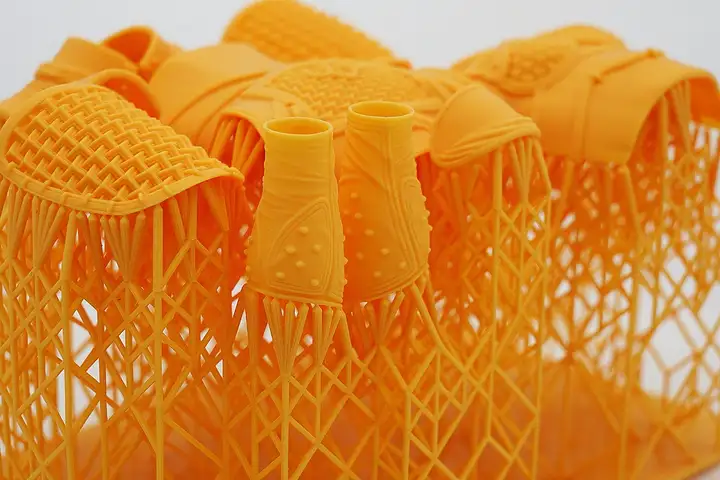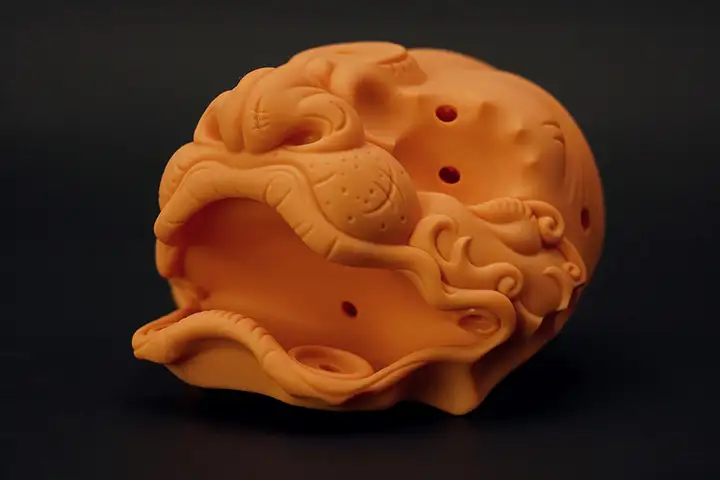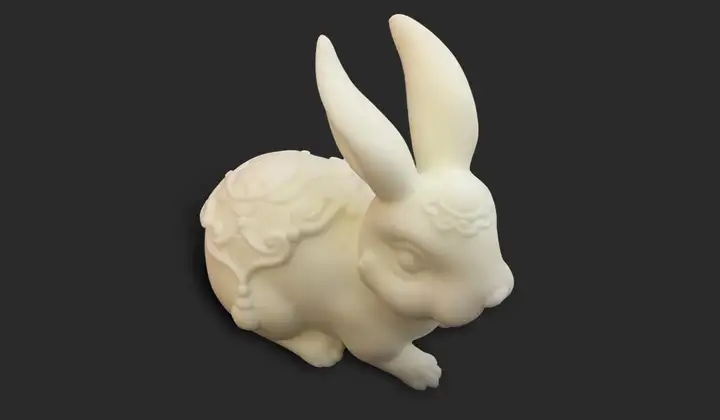What are the differences between the 3 common types of light-curing 3D printing technologies?
Light-curing molding is the earliest 3D printing and molding technology, and it is also the more mature 3D printing technology at present. The basic principle of this technology is to use the cumulative molding of materials, the shape of a three-dimensional target part is divided into several planar layers, a certain wavelength of light beam to scan the liquid photosensitive resin, so that each layer of liquid photosensitive resin is scanned part of the curing molding, while the place not irradiated by the light beam is still liquid, and finally each layer accumulated into the desired target part, the material utilization rate can be close to 100%.
Recently, light-curing 3D printers have been developing very well, because the printing accuracy is high and can reach micron level, so the mainstream 3D printer manufacturers have launched related models.

However, I believe that many attentive partners have found, in fact, there is not only one kind of light-curing 3d printer, there are 3 common on the market, including SLA light-curing 3d printer, DLP light-curing 3d printer and LCD light-curing 3d printer. So, what is the difference between these 3 kinds of light-curing 3D printers? Let’s take a look.
First, SLA light-curing 3D printer
SLA technology is the first generation of light-curing mainstream technology, it has a variety of translation in China called, such as three-dimensional lithography, three-dimensional printing, light modeling, etc. SLA molding technology is not only the world’s first to appear and commercialize a rapid forming technology, but also the most in-depth research, one of the most widely used rapid forming technology.

The basic principle of SLA molding technology is that mainly through the use of ultraviolet laser (355nm or 405nm) as the light source, and the vibrating mirror system to control the laser spot scanning, the laser beam on the surface of the liquid resin outline the shape of the first layer of the object, and then the production platform down a certain distance (between 0.05-0.025mm), and then let the curing layer immersed in the liquid resin, and so on and so forth, and finally complete the solid printing.
Second, DLP light-curing 3D printer
Digital Light Processing (Digital Light Processing, abbreviation: DLP) is more than ten years after the emergence of SLA technology, the technology is also recognized as the industry’s second generation of light-curing molding technology, the development history of more than 20 years ago. DLP technology was first developed by Texas Instruments and is an additive manufacturing technology that uses a projector to cure a photosensitive polymer liquid layer by layer to create a 3D printed object.

This molding technology first uses slicing software to slice the model thinly, the projector plays slides, each layer of the image in the resin layer is very thin area to produce photopolymerization reaction curing, forming a thin layer of the part, then the molding table moves a layer, the projector continues to play the next slide, continue processing the next layer, and so on, until the end of the print, so not only high precision molding, but also very fast printing speed.
Third, LCD light-curing 3D printer
Above on the SLA and DLP based on the two molding technology of 3d printer said a lot, now let’s talk about a new light-curing products LCD light-curing 3D printer.
LCD light-curing molding technology is actually just appeared in 2013. The point is that this technology is open source, and the core components are also very cheap.

Let’s talk about his molding principle. In fact, compared with the DLP molding technology, the simplest understanding of DLP technology is the light source with LCD instead, the other basic similar. LCD LCD plate imaging principle, the use of optical projection through the red, green and blue primary color filter to filter out infrared and ultraviolet light (infrared and ultraviolet light has a certain damaging effect on the LCD sheet), and then the three primary colors projected through the three LCD plates, synthetic projection imaging.

However, this molding technology requires the use of high-powered ultraviolet light irradiation, and the use of a very small amount of transmitted ultraviolet light for curing molding. The LCD screen itself is afraid of ultraviolet light, will be irradiated quickly after aging, while the core components in addition to withstand the test of heat and high temperature heat dissipation, but also to withstand tens of watts of 405 LED beads for several hours of high-intensity baking, so the service life is very short. If often used, its core components LCD screen often in one to two months will be damaged.
Fourth, the three printing technology comparison
Today, we will introduce and contrast the more common of these three technologies, SLA, DLP, LCD technology.
Forming speed: DLP>LCD>SLA
Print accuracy: DLP>SLA>LCD>FDM
Print size range: SLA>DLP>LCD
Material range: (DLP≈LCD)>SLA
Service life of main parts: DLP≈SLA>LCD
Machine price: SLA>DLP>LCD
Price of consumables: SLA≈DLP≈LCD
Scope of application.
SLA: finer parts such as cell phones, radios, walkie-talkies, mice, toys, electronic industrial housings, appliance housings or models, motorcycles, car parts or models, medical equipment, etc.
DLP: small precision parts, dental mold denture gingival guide and other dental, jewelry, research and development experiments, hand model, medical equipment
LCD: personal creator, entertainment. Smaller size models
V. Difference between SLA and DLP two molding technologies
SLA and DLP using consumables are light-curing resin, and the two molding technology principle is very similar, so the industry in the study of 3d printing molding technology, often like to treat these two technologies as similar technology, but the two in many ways there are actually still differences.
1.Mechanical structure: DLP uses digital light source of projector, while SLA uses UV laser light source.
2. Forming speed. Since DLP works by using digital micromirror elements to project product cross-sectional graphics onto the surface of liquid photosensitive resin, so that the irradiated resin is light-cured layer by layer, so the printing speed is very fast; while SLA uses a laser beam to outline objects on the surface of liquid resin, from point to line, and then from line to surface to form a solid model, so the work efficiency is much lower than the former.
3. Printing accuracy. Theoretically, the accuracy of both can reach micron-level printing accuracy, DLP can achieve the minimum spot size ± 50 microns, while SLA can achieve the minimum spot size ± 100 microns. Due to the high power of SLA laser and thus easy to lead to the formation of spot error, in addition to micron-level precision for the SLA laser and the main components of the mirror requirements are very high, the general domestic vibration crystal is difficult to meet the requirements, to achieve micron-level cost will increase significantly. In contrast, DLP is easier to reach the micron level. In summary, the DLP printing accuracy is higher than SLA.
4. print size. dlp is limited by the resolution of the digital mirror, compared to SLA can only print smaller size products.
In general, both technologies have their advantages and disadvantages, but in practice, DLP 3D printers clearly have the advantage.
UV Monomer Same series products
| Sinomer® ACMO | 4-acryloylmorpholine | 5117-12-4 |
| Sinomer® ADAMA | 1-Adamantyl Methacrylate | 16887-36-8 |
| Sinomer® DCPEOA | Dicyclopentenyloxyethyl Acrylate | 65983-31-5 |
| Sinomer® DI-TMPTA | DI(TRIMETHYLOLPROPANE) TETRAACRYLATE | 94108-97-1 |
| Sinomer® DPGDA | Dipropylene Glycol Dienoate | 57472-68-1 |
| Sinomer® DPHA | Dipentaerythritol hexaacrylate | 29570-58-9 |
| Sinomer® ECPMA | 1-Ethylcyclopentyl Methacrylate | 266308-58-1 |
| Sinomer® EO10-BPADA | (10) ethoxylated bisphenol A diacrylate | 64401-02-1 |
| Sinomer® EO3-TMPTA | Ethoxylated trimethylolpropane triacrylate | 28961-43-5 |
| Sinomer® EO4-BPADA | (4) ethoxylated bisphenol A diacrylate | 64401-02-1 |
| Sinomer® EOEOEA | 2-(2-Ethoxyethoxy)ethyl acrylate | 7328-17-8 |
| Sinomer® GPTA ( G3POTA ) | GLYCERYL PROPOXY TRIACRYLATE | 52408-84-1 |
| Sinomer® HDDA | Hexamethylene diacrylate | 13048-33-4 |
| Sinomer® HEMA | 2-hydroxyethyl methacrylate | 868-77-9 |
| Sinomer® HPMA | 2-Hydroxypropyl methacrylate | 27813-02-1 |
| Sinomer® IBOA | Isobornyl acrylate | 5888-33-5 |
| Sinomer® IBOMA | Isobornyl methacrylate | 7534-94-3 |
| Sinomer® IDA | Isodecyl acrylate | 1330-61-6 |
| Sinomer® IPAMA | 2-isopropyl-2-adamantyl methacrylate | 297156-50-4 |
| Sinomer® LMA | Dodecyl 2-methylacrylate | 142-90-5 |
| Sinomer® NP-4EA | (4) ethoxylated nonylphenol | 2156-97-0 |
| Sinomer® NPGDA | Neopentyl glycol diacrylate | 2223-82-7 |
| Sinomer® PDDA | Phthalate diethylene glycol diacrylate | |
| Sinomer® PEGDA | Polyethylene Glycol Diacrylate | 26570-48-9 |
| Sinomer® PEGDMA | Poly(ethylene glycol) dimethacrylate | 25852-47-5 |
| Sinomer® PETA | PETA Monomer | 3524-68-3 |
| Sinomer® PHEA | 2-PHENOXYETHYL ACRYLATE | 48145-04-6 |
| Sinomer® PO2-NPGDA | NEOPENTYL GLYCOL PROPOXYLATE DIACRYLATE | 84170-74-1 |
| Sinomer® TEGDMA | Triethylene glycol dimethacrylate | 109-16-0 |
| Sinomer® THFA | Tetrahydrofurfuryl acrylate | 2399-48-6 |
| Sinomer® THFMA | Tetrahydrofurfuryl methacrylate | 2455-24-5 |
| Sinomer® TMPTA | Trimethylolpropane triacrylate | 15625-89-5 |
| Sinomer® TMPTMA | Trimethylolpropane trimethacrylate | 3290-92-4 |
| Sinomer® TPGDA | Tripropylene glycol diacrylate | 42978-66-5 |
